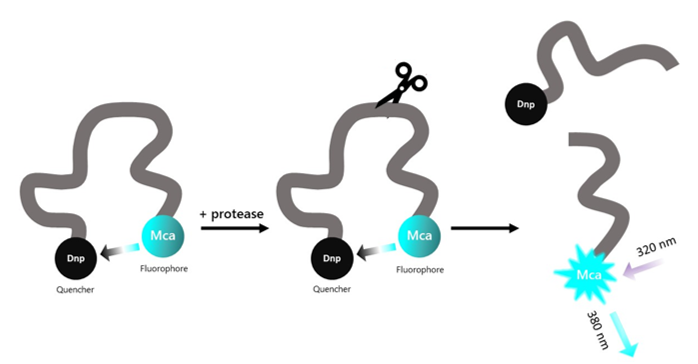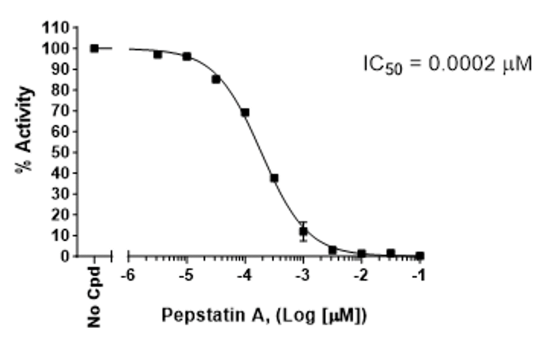Cathepsin D Inhibitor Screening Assay Kit
The Cathepsin D Inhibitor Screening Assay Kit is designed to measure the protease activity of Cathepsin D for screening and profiling applications. The Cathepsin D assay kit comes in a convenient 96-well or 384-well format, with enough recombinant human Cathepsin D (amino acids 21-412), its substrate, and Cathepsin buffer for 96 or 384 reactions. This kit contains Pepstatin A as internal control.

Figure 1: Illustration of the assay principle.
The substrate is an internally quenched fluorogenic substrate. Proteolysis releases the highly fluorescent substrate from the quencher. Fluorescence intensity increases proportionally to the activity of the protease.
Need us to run inhibitor screens or profile your compounds against Cathepsin D? Check out our Protease Screening Services.
- Adjustable micropipettor and sterile tips.
- Fluorescence plate reader capable of measurement at λex330/λem390 nm.
96 Reactions
| Catalog # | Name | Amount | Storage |
| 101391 | Cathepsin D, His-Tag* | >1 µg | -80°C |
| CS Substrate 2 | 12.5 µl | -20°C | |
| 4x Cathepsin Buffer | 2 ml | -20°C | |
| 0.5 M DTT | 200 μl | -20°C | |
| 10 mM Pepstatin A | 5 µl | -20°C | |
| 79685 | 96-well black microplate | 1 | Room Temp |
* The concentration of protein is lot-specific and will be indicated on the tube containing the protein.
384 Reactions
| Catalog # | Name | Amount | Storage |
| 101391 | Cathepsin D, His-Tag* | 2 µg | -80°C |
| CS Substrate 2 | 2 x 12.5 µl | -20°C | |
| 4x Cathepsin Buffer | 2 x 2 ml | -20°C | |
| 0.5 M DTT | 2 x 200 μl | -20°C | |
| 10 mM Pepstatin A | 5 µl | -20°C | |
| 79961 | 384-well black microplate | 1 | Room Temp |
* The concentration of protein is lot-specific and will be indicated on the tube containing the protein.
Cathepsin D is a lysosomal aspartyl protease, of the peptidase A1 family. It is involved in lysosomal protein degradation and activation of proteins that are synthesized as precursors, such as hormones and growth factors. Its activity impacts cell death and inflammation. Cathepsin D dysfunction has been linked to breast and gastric cancer, Alzheimer’s disease (AD) and neuronal ceroid lipofuscinosis (NCL). Overexpression of this protein can lead to activation of VEGF-C (vascular endothelial growth factor -C) and VEGF-D and metastasis and angiogenesis. Cathepsin D is therefore a promising new therapeutic target. It has been shown that an antibody against Cathepsin D was able to inhibit growth of triple-negative breast cancer cells. Cathepsin D inhibition is also a promising approach in combination treatments, by maximizing the effect of other anti-cancer drugs.
Seo S., et al., 2022 Cell Death and Disease 13: 115.



